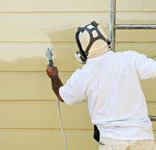Get Siding Savvy
 Homeowners have always had a love-hate relationship with siding. When first installed, it looks great; but in time, it can become dull, weathered or faded. A homeowner will often look to a paint professional for guidance in these situations. But with so many different types of siding materials marketed through the years—wood, aluminum, asphalt, cement, asbestos, vinyl, among others—a pro needs to have a strong understanding of a material’s strengths and weaknesses in order to guide customers.
Homeowners have always had a love-hate relationship with siding. When first installed, it looks great; but in time, it can become dull, weathered or faded. A homeowner will often look to a paint professional for guidance in these situations. But with so many different types of siding materials marketed through the years—wood, aluminum, asphalt, cement, asbestos, vinyl, among others—a pro needs to have a strong understanding of a material’s strengths and weaknesses in order to guide customers.
Here, a few painters shed light on some of the pitfalls and stumbling blocks when working with all types of siding materials.
BREATHING WOOD
Wooden clapboards have been the most popular type of siding since the 19th century, even though durable vinyl is the dominant material used in building and re-siding work today. Even though it’s not the first choice for today’s builders, wood clapboard repaints can still be the lion’s share of a paint pro’s siding business.
Chris Drucquer, owner of CertaPro Painters of the Main Line in suburban Philadelphia, PA, comes across one fatal flaw on wood siding jobs—caulked gaps, specifically those designed to allow wood to breathe and drain properly.
Wooden clapboards are laid horizontally in an overlapping manner to help water drain. These overlapped panels have gaps that can be seen on the underside of the clapboards. These thin gaps also serve as a necessary escape route for any moisture that may come from inside the house. It’s not uncommon for customers to ask a pro if these gaps could be caulked and painted over, said Drucquer.
“Siding is meant to breathe so moisture inside the house can get out. If it can’t find a way out, it pushes the paint off,” he added. “It’s a common request from homeowners, but doing this can cut the life of a paint job in half.”
AVOID THE ‘GLAZE’
A condition known as mill glaze in wood siding—mostly those made with the popular red cedar—is becoming increasingly common in some areas of the country.
Also referred to as planer’s glaze, it’s the result of a dull blade being used during the planning phase in wood-siding manufacturing. As a result, water extractives form on the overheated flat-grained side of the siding surface, making it difficult for paint to bond to. Chemists from the USDA’s Forest Products Laboratory describe the extractives as a ‘hard, varnish-like glaze.’ In some cases, even more extractives form on the surface during the kiln-drying process.
“The building booms created neighborhoods with a lot of mill glaze to deal with,” said Steven Oransky, a Five Star Painting franchisee in the North Shore Boston region. “You can’t really keep paint on [the wood siding] unless you entirely sand the surface and let it dry out.”
The first clue to a mill glaze situation is a higher than normal moisture reading in siding panels, said Oransky.
“We always use a moisture meter,” he added. “In this case, the water has migrated to the back of the clapboard, and it’s drying from the back to the front. The clapboard is pretty much gone.”
Oransky doesn’t blame paint crews on the original construction job for the early failures he sees. Mill glaze is hard to spot, especially on a construction site with a tight schedule, where the focus can quickly turn to speed at the expense of quality for all the trades involved. After working with mill-glazed boards quite a bit through the years, he has noticed they show more of a sheen when paint is first applied.
Mill glaze must be dealt with by sanding the surface. Most pros use a 50- to 80-grit sandpaper. Chemical mill glaze removal products have come to market as well; many, however, do not offer warranties. The USDA’s Forest Products Laboratory also recommends back-brushing the paint or stain to work it into the surface of the wood after sanding and properly prepping.
VINYL’S COLOR DILEMMA
For the past few decades, some homeowners have looked to vinyl to cover their original wood siding, bringing the attractive prospect of never having to paint again. But after 10 or 15 years, many vinyl converts simply want a new color scheme, or at least a refresh on their existing one.
“So many of those people don’t realize they can paint those substrates. They think they’re stuck,” said Mike Felten, a ProTect Painters franchisee in Yorkville, IL.
Vinyl is arguably paint’s best friend. As long as it’s clean, a quality paint will happily adhere to it.
In the past, however, paint color tints have been the problem area with vinyl siding paint jobs. Some pros advise against a darker color, as darker, low-VOC tints created a problem with hide, especially on surfaces heavily exposed to the sun. Drucquer has seen some darker colors “warp horribly” on vinyl jobs.
But more recently, Felten has seen some darker colors that look great. The best pros are aware of a paint manufacturer’s limitations on this front, and should seek out a paint brand whose reps are knowledgeable on the subject.
THOSE RARE ALUMINUM JOBS
In the 1940s and ’50s, aluminum siding looked like the solution to years of painting wood. But the light metal faded in popularity largely due to it being easily dented. Paint pros still encounter that occasional aluminum siding job.
Like vinyl, most aluminum surfaces, unless they are very slick, have plenty of bite and are ready for a coat, as long as they’re clean. Oxidation, or chalking, is what brings that ugly color fade to aluminum after years of being exposed to the elements. A good power-wash should clean the chalk off, says Drucquer. But sometimes the chalk can be stubborn; so the pro uses an aluminum siding conditioner product that can contain it and serve as a good priming coat. Most aluminum paint jobs should last a very long time, said Drucquer.
“It’s not like wood, where you’re dealing with moisture from the inside, or cracking of the surface. There’s no real peeling at all. I’ve done about 200 vinyl or aluminum jobs. Maybe only two have had any peeling,” he added.
HARD ADVICE
Felten has fielded his share of paint requests for fiber-cement siding in the past few years. Cement siding is rot-proof and insect resistant, and many manufacturers offer long warranties for colorfastness and durability.
Unfortunately, Felten is seeing some cement siding not meeting its colorfast warranty claims. Sometimes, it’s due to improper installation, and other times it’s a case of the product itself simply failing.
Felten suspects some cement-board material may be expanding and contracting during weather changes more than initially expected, which could also contribute to some paint failures. If the product is still inside the warranty window, the pro encourages homeowners to approach the manufacturer. In some cases, he has seen a manufacturer replace the product, and Felten’s team was called in afterwards to paint it.
Cement siding comes pre-primed, and so long as it is clean it takes a paint coat very easily, Felten added. He uses a higher-end elastomeric paint that will stand up to the expansion and contraction of concrete. But he also watches for actual surface failure. Sometimes cement siding can spall like sidewalk concrete. In that case, he says it’s important for pros to be very clear in their contracts.
“If the product is failing, I put a caveat in my proposals. We can paint over the material, but if the material is showing signs of deeper problems, I let the customer know about it. … I can’t warranty it if it’s shedding its skin,” he explained.
PREP POINTERS
Pros agree a job is only as good as its prep work. And when it comes to siding, a clean, dry surface is critical. While power-washing is standard for many, most pros like to use an additional cleaning agent as well.
Bill Torres, owner of Bill Torres Painting LLC, in Mount Joy, PA, has a specific process in place for power-washing a building. He has one crew member do an initial rinse, with someone else following right behind with a scrubber and cleaner. After scrubbing, another rinse is done.
“I tell owners when they’re looking at their homes to think of a car sitting for 10 or 20 years and not being washed. Even if rains rinses it off at times, it’s still going to be dirty and grimy,” he said.
Torres is also a bit obsessive about surface moisture. In the case of vinyl and aluminum, during power-washes, water can get caught in gaps and J-channels.
Felten’s general rule of thumb is that greater than 70˚ weather calls for one full day of drying, while below 70˚ requires two full days. He added that a house that is overdue on paint will probably need even more time.
“You hit that house with 3,200 psi (of water) and you better let it dry for several days,” Felten said.
LEAD, ASBESTOS CAUTION
Long banned in building applications, asbestos siding is still seen on many older homes. Chris Drucquer, who deals with his share of historic homes in his suburban Philadelphia region, still comes across the troubled building material.
“People still call and ask if you can slap a coat of paint on asbestos siding. But there are always concerns about dislodging the actual asbestos,” he said.
Sanding or scraping can potentially release asbestos fibers into the air and power-washing can disturb the surface as well.
Asbestos can pose challenges for any paint pro. Very few cities or states have laws that require using an asbestos removal company, but public fears over asbestos have mounted through the years. Any paint pro considering a job involving asbestos siding should do thorough research before making recommendations to clients.
Lead-based paint, banned in 1978, is also a concern, particularly on wood siding that is weathered and needs sanding. Childhood lead poisoning is the No. 1 health risk facing children in industrialized countries today, according to the Centers for Disease Control and Prevention (CDC).
“We have a lot of old houses out here with a lot of layers. So, yes, lead is always something we’re watching for too,” Drucquer added.
Painters must abide by the EPA’s four-year-old Lead Renovation, Repair and Painting (RRP) Rule before proceeding with work on a home with lead-based paint.
To learn more about asbestos impacts, visit www2.epa.gov/asbestos
To learn more about becoming RRP-certified, visit the EPA at www2.epa.gov/lead/epa-lead-safe-certification-program




